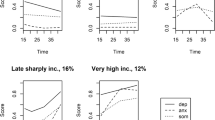Abstract
It is now standard practice in psychopathology research to longitudinally assess the predictive effects of putative etiological factors on symptoms. A common statistical technique employed in the implementation of such research is multiple regression/correlation, with a baseline symptom measure used as a covariate in an analysis of the association between etiological factors and future symptoms. This report highlights the importance of testing the assumption of homogeneity of covariance in such analyses, not only because it is statistically required, but also because it provides theoretically relevant information regarding onset, exacerbation, or remission of symptoms.
Similar content being viewed by others
References
Abramson, L. Y., Metalsky, G. I., & Alloy, L. B. (1989). Hopelessness depression: A theory-based subtype of depression.Psychological Review, 96, 358–372.
Barnett, P. A., & Gotlib, I. H. (1988). Psychosocial functioning and depression: Distinguishing among antecedents, concomitants, and consequences.Psychological Bulletin, 104, 97–126.
Beck, A. T., Rush, A. J., Shaw, B. F., & Emery, G. (1979).Cognitive therapy of depression. New York: Guilford Press.
Brown, G. W., & Harris, T. (1978).Social origins of depression, London: Tavistock.
Cohen, J. (1968). Multiple regression as a general data-analytic system.Psychological Bulletin, 70, 426–443.
Cohen, J. (1978). Partialed productsare interactions; partialed powersare curve components.Psychological Bulletin, 85, 858–866.
Cohen, J., & Cohen, P. (1983).Applied multiple regression/correlation analysis for the behavioral sciences (2nd ed.), Hillsdale, NJ: Erlbaum.
Dwyer, J. H., Feinleib, M., Lippert, P., & Hoffmeister, H. (Eds.). (1991).Statistical models for longitudinal studies of health. New York: Oxford University Press.
Hollon, S. D., Kendall, P. C., & Lumry, A. (1986). Specificity of depressotypic cognitions in clinical depression.Journal of Abnormal Psychology, 95, 52–59.
Joiner, Jr., T. E., Alfano, M. S., & Metalsky, G. I. (1992). When depression breeds contempt: Reassurance-seeking, self-esteem, and rejection of depressed college students by their roommates.Journal of Abnormal Psychology, 101, 165–173.
Joiner, Jr., T. E., Alfano, M. S., & Metalsky, G. I. (1993). Caught in the crossfire: Depression, self-consistency, self-enhancement, and the response of others.Journal of Social and Clinical Psychology, 12, 113–134.
Joiner, Jr., T. E. Schmidt, N. B., & Singh, D. (in press). Waist-to-hip ratio and body dissatisfaction among college women and men: The moderating roles of depressed symptoms and gender.International Journal of Eating Disorders.
Metalsky, G. I., & Joiner, Jr., T. E. (1992). Vulnerability to depressive symptomatology: A prospective test of the diathesis-stress and causal mediation components of the hopelessness theory of depression.Journal of Personality and Social Psychology, 63, 667–675.
Metalsky, G. I., Joiner, Jr., T. E., Hardin, T. S. & Abramson, L. Y. (1993). Depressive reactions to failure in a naturalistic setting: A test of the hoplessness and self-esteem theories of depression.Journal of Abnormal Psychology, 102, 101–109.
Roberts, J. E., & Monroe, S. M. (1992). Vulnerable self-esteem and depressive symptoms: Prospective findings comparing three alternative conceptualizations.Journal of Personality and Social Psychology, 62, 804–812.
Robins, C. J., & Block, P. (1989). Cognitive theories of depression viewed from a diathesis-stress perspective: Evaluations of the models of Beck and Abramson, Seligman, and Teasdale.Cognitive Therapy and Research, 13, 297–313.
Author information
Authors and Affiliations
Additional information
This report was supported in part by a University Fellowship from the University of Texas at Austin to Thomas Joiner.
Rights and permissions
About this article
Cite this article
Joiner, T.E. Covariance of baseline symptom scores in prediction of future symptom scores: A methodological note. Cogn Ther Res 18, 497–504 (1994). https://doi.org/10.1007/BF02357756
Issue Date:
DOI: https://doi.org/10.1007/BF02357756




